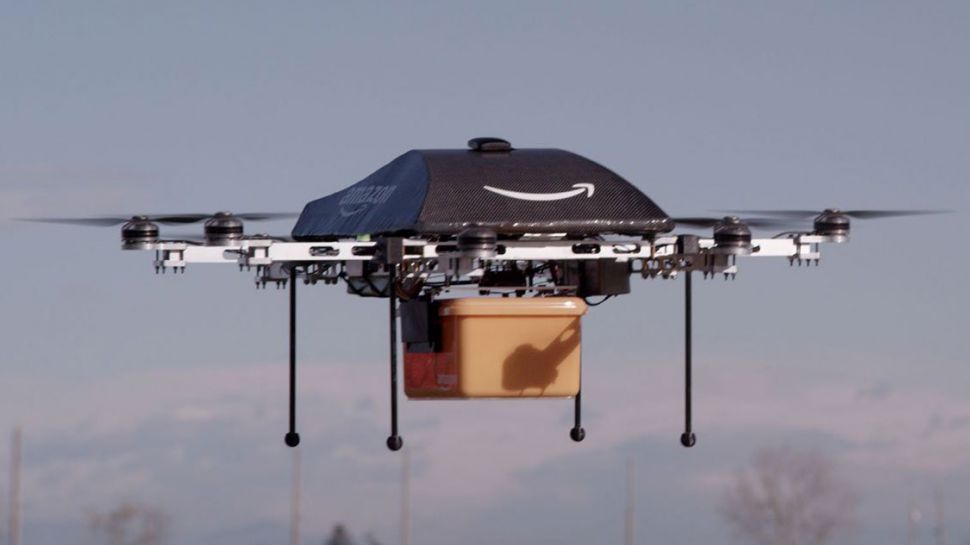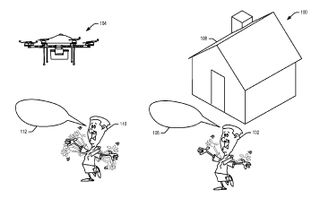Amazon patent reveals its delivery drones could have face and gesture recognition
Teaching drones to recognize our terror

Amazon would probably like to just parachute packages to you from a safe distance. But the company's latest patent suggests it thinks it might be safer to just fly drones directly in front of customers instead of risking broken Amazon Fire tablets (or concussions).
To potentially aid in this, the retail giant has filed a patent for a package delivery drone with a sensor system for registering both “visible“ and “audible“ gestures. Drones will communicate with a gesture database that will help it to recognize what you’re trying to get it to do, like 'Fly over there!' or 'Back off!'
Ironically, the patent image, first discovered by GeekWire, looks more like a man screaming and flailing in terror as a drone descends. But the patent itself hints at some complex technology to prevent accidents.

The patent indicates that the drone could be equipped with visible and infrared light cameras, depth sensors, motion scanners, and input and output microphones and noise filters for sound.
With these sensors, the theoretical drone will be able to recognize gestures and “adjust its trajectory and/or speed“ based on your instructions.
And to ensure that some random person on the sidewalk doesn’t disrupt your delivery, the drone could have the ability to “verify an identity of the human user prior to instructing the retaining system to implement the behavior adjustment.“
It would do this by by using the cameras to compare your appearance to that of the Amazon account owner or purchaser – or by receiving confirmation from a user's device (like a smartphone confirmation code).
Get daily insight, inspiration and deals in your inbox
Sign up for breaking news, reviews, opinion, top tech deals, and more.

The listing also suggests that the gesture database could store new, unique gestures it sees from users, and remember how to respond to them for future deliveries.
Whether or not you think that's a helpful service feature or a dystopian invasion of privacy probably depends on whether you think it’s a good or bad idea to have a smart speaker that recognizes your voice in your home.
Your friendly neighborhood drone
Amazon isn’t the first to think up this kind of technology. The DJI Spark added PalmControl functionality, which lets you control your Spark with hand motions and instruct it to perform actions, like take an air-selfie.
But Spark users choose to have drone flying around their heads. Amazon has to account for people who might be inclined to treat the aircraft as hostile, and program the fliers to know how to respond to hostile gestures, as well as directional ones.
Like all patents, this is no guarantee that the feature will be implemented in Amazon’s final delivery service. Amazon has also patented a self-destruct feature to vaporize drones in the air rather than risk them landing on passersby.
But another patent spotted by GeekWire last year lends credence to the notion that Amazon wants the delivery drones up close and personal with customers.
This patent, focused on speech interaction, described how drones would “produce speech in order to warn or instruct” customers away.

Amazon also suggested the drones could have “automatic speech recognition (ASR) and natural language understanding (NLU) capabilities”, which strongly suggests the drone would have built-in Alexa functionality for its “two-directional speech dialog” with customers.
While the drone could also connect the customer with an Amazon “support representative”, the patent suggests this is more of a last resort.
The latest patent, which says the drone could respond to “audible gestures”, could easily be linked with an Alexa-based audible response program. But we’ll have to wait and see whether either (or both) of these patented designs make it into Amazon’s final drone model.
Via The Verge
- Best drone 2018: find a great done to fly
Michael Hicks began his freelance writing career with TechRadar in 2016, covering emerging tech like VR and self-driving cars. Nowadays, he works as a staff editor for Android Central, but still writes occasional TR reviews, how-tos and explainers on phones, tablets, smart home devices, and other tech.





















